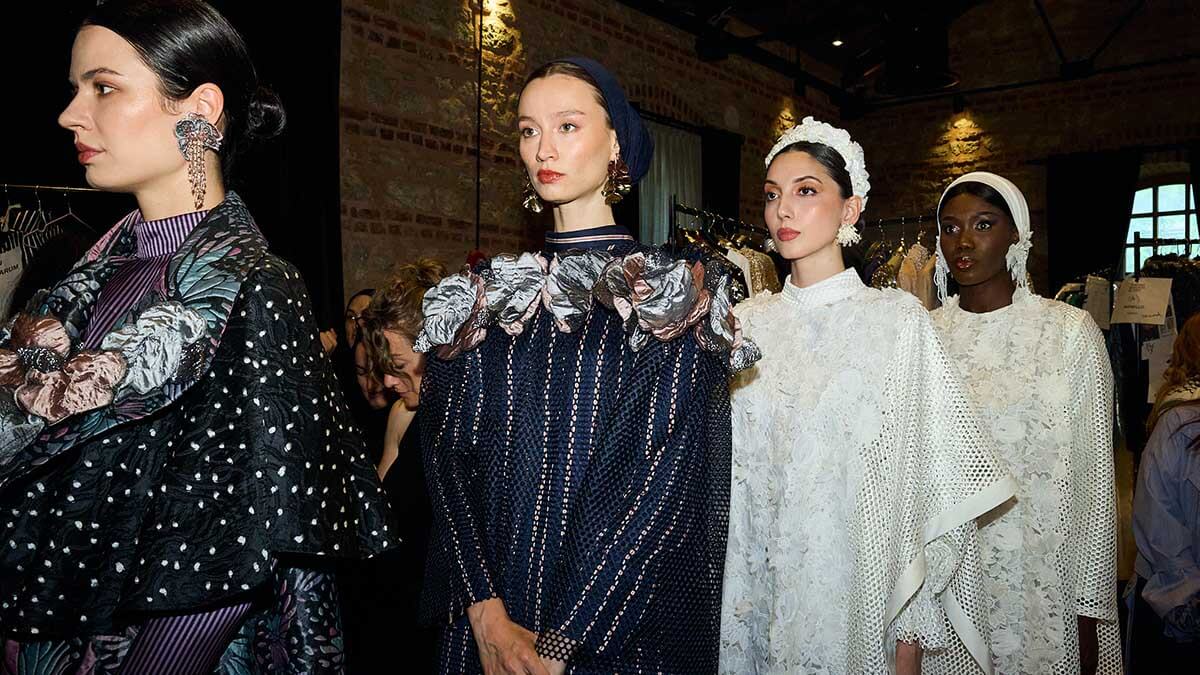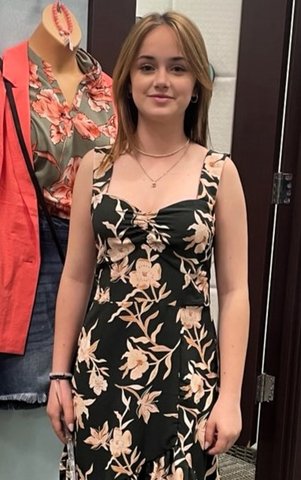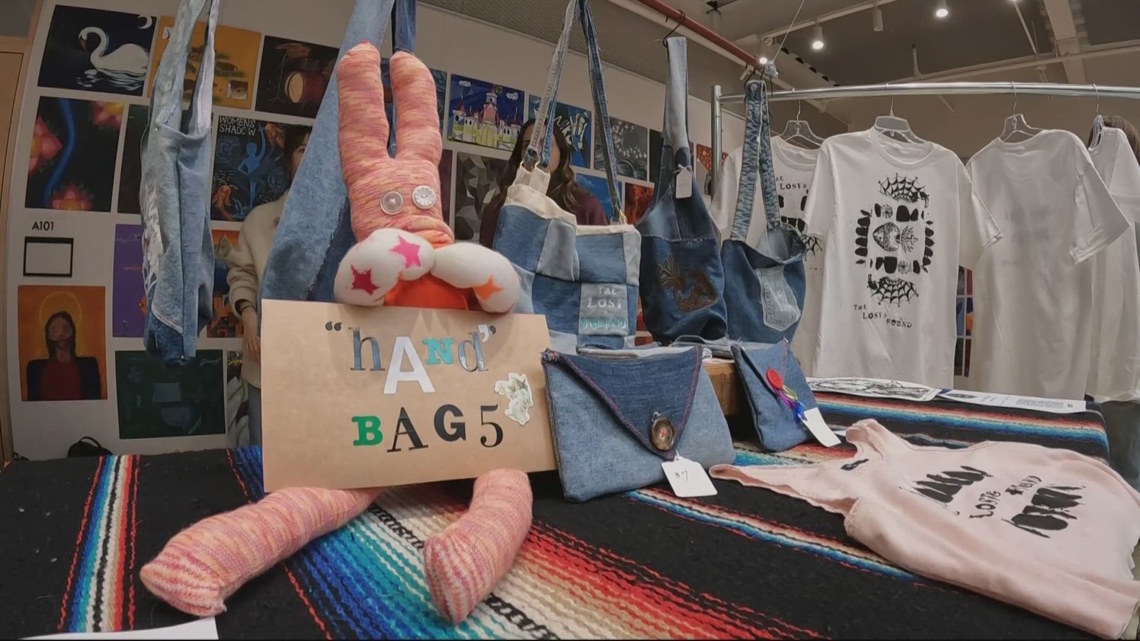Sign up to our newsletter for a truly global perspective on the fashion industry
Enter your email to receive editorial updates, special offers and breaking news alerts from Vogue Business. You can unsubscribe at any time. Please see our privacy policy for more information.
Sign up to receive the Vogue Business newsletter for the latest luxury news and insights, plus exclusive membership discounts.
On the outskirts of Istanbul, on the shore of the Marmara Sea, sits the Fişekhane — one of the first industrial sites of the Ottoman Empire, dating back to the 1800s. A stone backdrop and its high ceiling — peppered with skylights — make it a suitably dramatic venue for fashion shows. It is here that the ninth edition of Modest Fashion Week (MFW) took place, featuring collections from 27 designers from countries across the world.
MFW’s return to Istanbul — the city where it began — is significant. Since the first event in 2016, it has been travelling to various global locations, including London, Amsterdam, Jakarta and Dubai. This edition, which took place from 25 to 27 April, aimed to unite the community in a country that is celebrated for its modestwear, while promoting Türkiye’s manufacturing, production and collaboration opportunities after a difficult period for the country following last year’s earthquake.
“We’ve always had a market for modest fashion in Türkiye but what we can now see changing is that the market has become more open — welcoming global designers, buyers and talent, instead of working exclusively within the country,” says Modest Fashion Week’s Turkish co-founder Ozlem Sahin Ertas.
Thanks in part to its travelling format, MFW has been gaining attention on a global stage. Of the brands that took part this season, some were local to Türkiye, such as Imannoor, Zems, Marina and Miha, but many came from other countries and regions, including the Middle East, Indonesia, Pakistan, South Africa, the US and Australia. Highlights included Buttonscarves, Nada Puspita and Benang Jarum, which showcased modestwear in its entirety (not just through clothing, but also headscarves and accessories). On the other hand, Australia’s Akkoia demonstrated how its sheer maxi dresses can be modestly styled, or not, depending on how they are layered.
Opening the three-day event, Hilal Oğuzkan showed a collection that was couture-like in its construction and opulence — think pearls and embroidered jewels. Fellow Turkish designers Rafaello and Terzi Dükkani highlighted the versatility of ready-to-wear, with modest options that can be adapted to different climates.
This edition of MFW was well timed to tap into the changing narrative around modest fashion, which is being driven largely by social media — especially TikTok. From grunge-inspired pieces to workwear and layered designer looks, interpretations of modest fashion are broadening, with many of the MFW shows celebrating difference and community.
Influencers such as Soha Taha and Fatema Alawadhi were in attendance, while high-profile models including Halima Aden and Rawdah Mohamed were spotted on the runway. “Modest Fashion Week does a great job of highlighting global emerging talent and designers who typically wouldn’t get recognition for their work in high-fashion spaces. It’s an accessible platform that is dependent on supporting each other as a community,” Aden tells Vogue Business.
Ertas would like to grow the event to feature more designers, but says she is held back by the logistical and financial challenges of orchestrating a smaller scale fashion week with a global footprint. “Financial constraints are one of our biggest challenges, so we need to prioritise having the right partners to be able to support the event and also align with our vision for the modestwear industry, before we can go ahead with it,” she explains.
That said, its smaller scale holds some advantages. “It allows us to give our designers a chance to properly be noticed by the industry and we can focus on supporting them one-on-one,” says Ertas.
Last year’s earthquake devastated regions across Türkiye and its neighbouring countries that are heavily dependent on textile manufacturing. The country has shown its resilience in building back after the damage, though concerns around conditions in the supply chain linger, and inflation and rising costs are proving a challenge.
Despite these challenges, some local designers are reshoring their production to Türkiye to improve quality and cut costs. “Some of the participants wanted to explore these opportunities and they do so by either having on-site meetings at the event or visiting production sites and fabric shops with extended stays,” says Ertas.
Designers — including those from Türkiye — say it was an education in the advantages of using Turkish materials. “The quality of cotton, silk and linen is something that is very essential [for modestwear], especially when it comes to buying for GCC (Gulf Cooperation Council) countries where it is hot seven to eight months of the year,” explains Swati Raval, modestwear buyer for Dubai-based retail company Landmark Group.
“In the past we were exporting raw materials from different countries but now Türkiye’s production is developing, which has helped us save money,” says Oğuzkan, founder and designer of her eponymous label.
Australian ready-to-wear brand Akkoia showcased its second collection for the first time at MFW, featuring pastel and floral-print maxi dresses, hand-woven knits and lace details, made mostly from silks and tencel. The brand was seeking production facilities that align with its ethos of being as transparent as possible with its customers about how the clothing is made, says the brand’s head designer Bahar Acahan.
“We are transitioning our production from Australia and China to Türkiye because they are more transparent about their supply chain. It’s a priority for us because Australia [has a target to] become 100 per cent carbon neutral by 2050, and we need to be able to reference how our clothing is made,” says Acahan. “It’s very expensive to produce in Australia so Türkiye has been a great alternative that balances product quality, transparency and fair pricing.”
Istanbul-based brand Zems uses cupro fabric to create abaya-like designs that explore various methods of draping and cinching. The brand’s production facilities were not directly affected by the earthquake, but it was still challenging to sell products during that time.
“We were hit by the pandemic and then the earthquake,” says Ayse Merve Sonmez, co-founder of Zems. “We finally feel we have a solid opportunity to sell and grow. It’s still challenging to gauge our business’s success due to a number of uncertainties we’ve had to adapt to, but we recognise there’s a market and we know our product quality and fabrics are good, so we’re going to keep pushing that.”
One of MFW’s aims is to unite the global modestwear community. Designers say this is an important motivator for taking part. “Even though Indonesia could be perceived as a competitor [to Türkiye], there’s a strong support system behind the scenes within our community,” says Indah Nada Puspita, founder of Jakarta-based brand Nada Puspita. “The modest industry requires mutual support to grow — we are a relatively small community in comparison to the wider fashion industry,” adds Buttonscarves CEO Linda Anggrea (both brands are owned by Modinity Group).
Model and Vogue Scandinavia editor Mohamed also reflects on the strengthened sense of community within the modestwear industry. “Because of social media everyone knows of one another and so the community is much stronger and everyone comes together to create these kinds of events. Previously, there were geographical divides between regions like Türkiye, Indonesia and Dubai. Now, everyone collaborates to make events like Modest Fashion Week what it is,” she says.
Three new countries have expressed interest in potentially hosting Modest Fashion Week in the upcoming years, Ertas says, though it’s too early to say where it will go next.
“The goal for the future is to nurture smart and fruitful partnerships between industry stakeholders,” she explains “It’s more than just the runway. It’s a long chain working with our designers from the idea, to choosing the right materials and production and then targeting the right markets, buyers and people that share the same values.”
Comments, questions or feedback? Email us at feedback@voguebusiness.com.
Sign up to our newsletter for a truly global perspective on the fashion industry
Enter your email to receive editorial updates, special offers and breaking news alerts from Vogue Business. You can unsubscribe at any time. Please see our privacy policy for more information.


